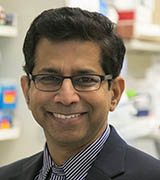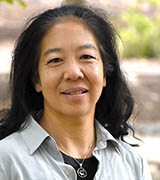Colleagues: Recently Tenured
Meet your recently tenured colleagues: Ursula Buchholz (NIAID, pictured), Nicholas Guydosh (NIDDK), Senthil Muthuswamy (NCI-CCR), Tonya White (NIMH), and Sabrina Wong (NINR).
URSULA BUCHHOLZ, D.V.M, PH.D., NIAID
Senior Investigator and Chief, RNA Viruses Section, Laboratory of Infectious Diseases (LID), National Institute of Allergy and Infectious Diseases

Education: Free University Berlin, Berlin (D.V.M.; Ph.D. in virology)
Training: Research Fellow, Free University Berlin; postdoctoral fellow, Institute of Clinical Virology, Federal Research Institute for Animal Health (Tübingen, Germany)
Before coming to NIH: Principal Investigator with tenure, Institute of Molecular Biology, Federal Research Institute for Animal Health (Insel Riems, Germany)
Came to NIH: In 2002 as a Staff Scientist, Respiratory Viruses Section, LID, NIAID
Outside interests: Enjoys outdoor activities with family and friends—hiking, biking, sailing; enjoys music, especially her beginner cello lessons
Website: https://www.niaid.nih.gov/research/ursula-buchholz-phd
Research interests: My laboratory studies the molecular virology, pathogenesis, and immune response of human respiratory pathogens, including respiratory syncytial virus (RSV), human parainfluenza viruses (HPIVs), and human metapneumovirus. We are using insights from our basic virology studies to develop effective mucosal vaccines against respiratory viruses.
The pneumovirus RSV is the most important cause of severe acute lower respiratory illness in infants and children worldwide and is a leading cause of infant hospitalizations. There are no licensed vaccines. We recently advanced two promising live-attenuated vaccines into pediatric clinical studies and found that a single intranasal dose was safe and induced an immune response in RSV-seronegative children, warranting further evaluation (J Infect Dis 221:534-543, 2020; J Infect Dis 222:82-91, 2022). These lead candidates are advancing to later-stage clinical trials.
We are also using paramyxoviruses and pneumoviruses as vaccine vectors to express protective antigens of RSV or other emerging pathogens. In 2020, we expanded our program to include the development of vector-vaccine candidates for intranasal immunization against SARS-CoV-2, the virus that causes COVID-19. In a recent study, we generated a live-attenuated parainfluenza-virus-vectored vaccine candidate expressing the SARS-CoV-2 prefusion-stabilized spike protein (B/HPIV3/S-6P) and evaluated its immunogenicity and protective efficacy in rhesus macaques (Macaca mulatta). We found that a single intranasal immunization with B/HPIV3/S-6P vaccine candidate was highly immunogenic and protected macaques against SARS-CoV-2 (Cell 185:4811-4825, 2022; DOI: 10.1016/j.cell.2022.11.006). Our data support the further development of this vaccine candidate for potential use as a stand-alone vaccine and/or in a prime or boost combination with injectable SARS-CoV-2 vaccines for infants and young children. The B/HPIV3/S-6P vaccine candidate will be evaluated in a phase 1 study.
NICHOLAS GUYDOSH, PH.D., NIDDK
Senior Investigator and Chief, Section on mRNA Regulation and Translation, Laboratory of Biochemistry and Genetics, National Institute of Diabetes and Digestive and Kidney Diseases

Education: Harvard University, Cambridge, Massachusetts (A.B. in chemistry); University of Cambridge, Cambridge, England (M.Phil. in chemistry); Stanford University, Stanford, California (Ph.D. in biophysics)
Training: Postdoctoral Fellow, Department of Molecular Biology and Genetics, Johns Hopkins University School of Medicine (Baltimore)
Came to NIH: In 2016 as a Stadtman Investigator and Acting Chief of his current section in NIDDK
Outside interests: Reading; being outdoors; exploring the Washington, D.C., area with his daughter
Website: https://irp.nih.gov/pi/nicholas-guydosh
Research interests: I lead a research group that is seeking to learn how cells change the expression of genes by controlling how ribosomes translate messenger RNAs (mRNAs) during protein synthesis. We’re interested in the mechanisms that underlie the basic steps of translation as well as how these processes are regulated to maintain cellular health. We have made several key advances that have relied on enhancements to the ribosome-profiling methodology: We use a high-throughput footprinting approach to map the positions of ribosomes along mRNAs.
One area we are studying is ribosome recycling, the process by which ribosomal subunits are separated from each other and from mRNA after the completion of protein synthesis and are made ready to be reused in the next round of translation. Scientists did not know how recycling worked or if it was promoted by particular proteins. We recently discovered that recycling occurs in stages and each subunit of the ribosome is removed separately by specific proteins (Nat Commun 12:2976, 2021). Because these proteins are encoded by oncogenes and can be mutated in people with autism, our finding suggests ribosome recycling is an important process to consider for understanding cancer, autism, and potentially other neurological diseases.
We are also interested in the consequences of cases where translating ribosomes bump into each other. It turns out that these ribosome collisions occur more often when cells experience stress, such as starvation. We discovered that ribosome collisions activate a key signaling pathway—the integrated stress response—that helps the cell cope with stress and plays broad roles in neurological diseases, cancer, and viral infections. (Mol Cell 79:588-602.e6, 2020).
SENTHIL MUTHUSWAMY, PH.D., NCI-CCR
Senior Investigator and Chief, Laboratory of Cancer Biology and Genetics, Center for Cancer Research, National Cancer Institute

Education: Tamil Nadu Agricultural University, Coimbatore, India (B.Sc. in agricultural sciences and M.Sc. in genetics); McMaster University, Hamilton, Ontario, Canada (M.Sc. in biology; Ph.D. in biology)
Training: Postdoctoral Fellow, ARIAD Pharmaceuticals (Cambridge, Massachusetts); Postdoctoral Fellow in cell biology, Harvard Medical School (Boston)
Before coming to NIH: Harvard Medical School: Director of the Cell Biology Program and of Translational Research, Beth Israel Deaconess Medical Center; associate professor, Department of Medicine and Pathology, Beth Israel Deaconess Medical Center; and investigator, Harvard Ludwig Cancer Center
Came to NIH: In 2022
Outside interests: Gardening; taking photographs; hiking; playing badminton
Website: https://irp.nih.gov/pi/senthil-muthuswamy
Research interests: During my postdoctoral fellowship, I was among the first to use three-dimensional cell cultures (organoids) to bridge the gap between growing cells as flat monolayers and in vivo to study oncogenesis (Nat Cell Biol 3:785-792, 2001). In my laboratory, we continue to generate patient-tumor-derived organoid cultures (Nat Med 21:1364-1371, 2015) and use them for investigating drug response, biomarkers (JCI Insight 5:e135544, 2020), metastatic progression (Nat Cell Biol 15:189-200; 2013), and personalized cancer treatments (Clin Cancer Res 28:708-718, 2022).
More recently, we developed a tumor organoid-immune cell co-culture platform in which peripheral-blood-derived T cells undergo a dramatic clonal expansion (1,000- to 100,000-fold). These organoid-primed cytotoxic T (opT) cells express tumor-targeting T-cell receptors (TCRs) and are useful for cell-therapy applications (J Immunother Cancer 9:e003213, 2021). Expansion of T cells in response to antigens naturally expressed on the surface of tumor organoids defines opT culture as a unique, empirical platform to identify tumor-selective cytotoxic cells for use in immune-therapy applications and to identify a new class of TCRs and tumor antigens.
The three-dimensional culture of epithelial cells is exquisitely suited for studying apical-basal polarization and its role in cancer biology. Although we were the first to show that polarity proteins function as tumor suppressors in mammals (Cell 135:865-878, 2008; Nat Cell Biol 8:1235-1245, 2006), our recent studies have challenged this notion. We find that cell polarity proteins function as positive regulators by altering cell metabolism and the trafficking of cell-surface proteins to provide growth and survival advantage to cancer cells (Nature 569:275-279, 2019). Consistent with our findings, many cell-polarity proteins are overexpressed or amplified in cancer (Biochim Biophys Acta Rev Cancer 1869:103-116, 2018). This highlights a new opportunity for using tumor organoids and immune-cell co-culture platforms to investigate how cell-polarity proteins regulate changes in cellular metabolome, cell-surface proteome, and cell signaling to promote metastatic-cancer progression and treatment resistance.
TONYA WHITE, M.D., PH.D., NIMH
Senior Investigator and Chief, Section on Social and Cognitive Developmental Neuroscience, National Institute of Mental Health

Education: University of Utah, Salt Lake City (B.S. in electrical engineering); University of Illinois at Champaign/Urbana (M.S. in electrical engineering); University of Illinois College of Medicine, Chicago (M.D.); University of Minnesota, Minneapolis and Saint Paul, Minnesota (coursework toward Ph.D. in biomedical engineering); Erasmus University Rotterdam, Rotterdam, Netherlands (Ph.D. in developmental neuroscience)
Training: Combined residency in pediatrics, in psychiatry, and in child and adolescent psychiatry, University of Utah; postdoctoral research fellowship, University of Iowa Hospitals and Clinics (Iowa City, Iowa)
Before coming to NIH: Professor of Pediatric Population Neuroimaging in the Departments of Child and Adolescent Psychiatry and of Radiology and Nuclear Medicine, Erasmus University Rotterdam
Came to NIH: In July 2022
Outside interests: Cross-country, telemark, and Alpine skiing; cycling; paddling; hiking; enjoys spending time with family and friends doing outdoor activities or over food and drink; listening to books on tape; and writing
Research interests: Children or adolescents with the same psychiatric diagnosis can have varying degrees of core and comorbid symptoms. Even monozygotic twins, whose identical genetic makeups allow for highly similar individuals, differ in specific characteristics. These individual differences are attributed to nonshared environmental factors, many of which are random and can’t be measured. My long-term goals are to better understand individual differences—including the interplay among genes, environment, and random processes—in youth with mental-health disorders. Even twins who are concordant for a specific disorder, such as autism, may have considerable differences in symptoms. Thus, a better understanding of factors that can influence symptom domains across the continuum can shed light onto the underlying mechanisms of mental-health problems. My recent work has pointed to both prenatal and early life as critical periods to foster optimal brain development and to reduce the risk for children developing a psychiatric disorder.
While there is heterogeneity in symptom domains, it is interesting that the core symptoms of specific disorders, albeit differences in severity, have classic patterns that cluster together and allow for identification. Thus, one of my other goals is to apply machine-learning and pattern-recognition algorithms to be able to extract the brain-based patterns associated with the spectrum of symptoms. I also have a long-standing interest in developing primary prevention strategies for young children to (hopefully) help curb the onset of neurodevelopmental disorders.
My group recently conducted several population-based neuroimaging studies to investigate the bidirectional, longitudinal relationship between behavioral traits, including autistic traits, and brain morphology in children. Whereas we found that the interplay between autistic traits and structural brain measures are relatively stable across childhood, children with depression, anxiety, aggression, and attention problems show greater brain changes over time. Timing matters. We demonstrated that higher levels of autistic traits are associated with lower gyrification (the development of fissures and folds on the brain’s surface) between 6 and 15 years of age. Overall, our findings point toward alterations in specific brain regions that are involved in social cognition (Mol Autism 13:31, 2022; Am J Psychiatry 175:54-62, 2018; and a paper, in press, in the Journal of the American Academy of Child and Adolescent Psychiatry).
SABRINA WONG, PH.D., R.N., NINR
Senior Investigator and Scientific Director, National Institute of Nursing Research

Education: University of British Columbia, Vancouver, British Columbia, Canada (B.S.N.); University of California at San Francisco (M.S. and Ph.D. in nursing)
Training: Postdoctoral Fellow at the Institute for Health Policy Studies, University of California at San Francisco
Before coming to NIH: Associate Director, Research School of Nursing, and Professor of Nursing, University of British Columbia
Came to NIH: In September 2022
Outside interests: Running marathons and ultramarathons; hiking; enjoys other outdoor activities
Website: https://www.ninr.nih.gov/aboutninr/sabrina-wong
Research interests: I have a long-standing interest in the organization and delivery of primary health care services and how to reduce inequities in health and health care. I have combined my expertise in psychometric measurement, use of mixed methods, patient-oriented research, and use of large data such as administrative and electronic medical record data (Healthc Policy 17:19–23, 2021). I have led ongoing work to develop primary health care science, including the development of federating primary-care electronic medical records into Canada’s largest data repository of its kind, the Canadian Primary Care Sentinel Surveillance Network.
I was pleased to be recognized as one of Canada’s leading experts in primary health care research: I was nominated principal investigator of a community-based primary health care innovation team grant; asked to provide consultations internationally; and invited to contribute an editorial in the British Medical Journal (BMJ 346:f3777, 2013).
I help identify issues where primary care can intervene. One important matter is the inappropriate prescribing of antibiotics for treating respiratory tract infections (RTIs)—25% to 68% of prescriptions for RTIs are potentially avoidable (Can Commun Dis Rep 48:157-163, 2022). Finding ways to provide useful information from electronic medical record data to inform quality improvement interventions in primary care can, for example, raise awareness about inappropriate antibiotic prescribing practices and could be vital to advancing antimicrobial stewardship.
I am also exploring how team-based primary care (in which two or more health professionals work collaboratively to provide comprehensive, continuous, and coordinated care) contributes to high-performing health care services. In a recent study, we determined that primary-care teams are most effective when they are small (fewer than 11 professionals), they communicate informally with one another, and they share the practice’s mission, values, and objectives. Larger teams that rely primarily on electronic medical records to coordinate care were less effective (J Interprof Care 26:1-10, 2022).
This page was last updated on Sunday, January 8, 2023
